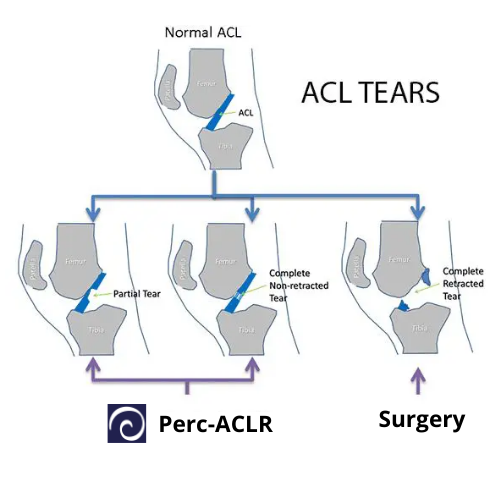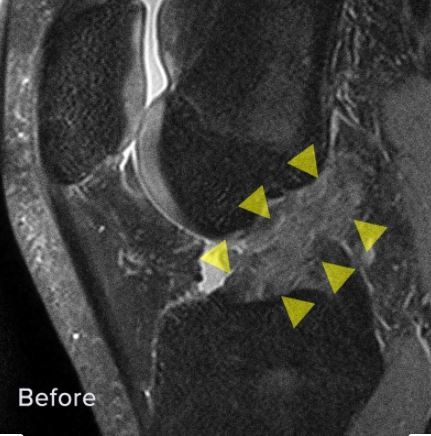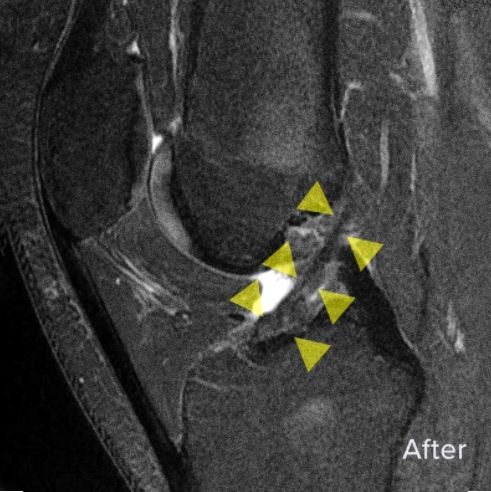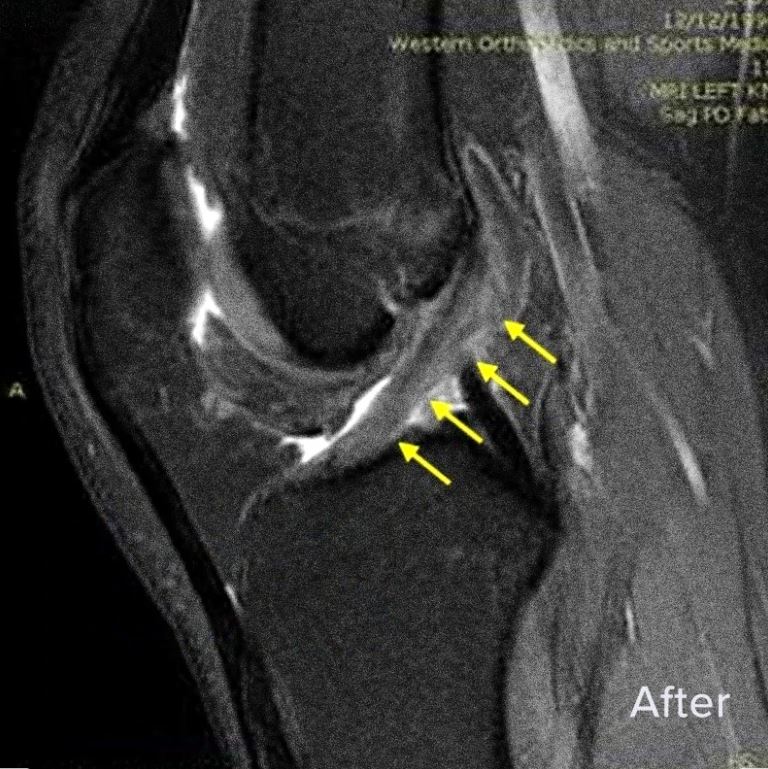Non-surgical Treatment for ACL Tear in Colorado
Your Trusted Alternative to ACL Surgery
Am I a Candidate?Want to Avoid ACL Surgery?
Consider Regenexx’s Non-Surgical Treatment for ACL Tear
The Regenexx® Perc-ACLR procedure for ACL tears was developed to treat full and partial anterior cruciate ligament tears non-surgically. ACL tears are one of the more common knee injuries we treat and many non-retracted full and partial tears can be treated in all but the most serious cases.
The procedure is comprised of a highly precise X-ray-guided injection of your own concentrated cells, which can be completed in one day. It is far less invasive than surgery, and generally requires far shorter recovery times than ACL reconstruction surgery.
The Perc-ACLR, the trusted alternative to ACL surgery, offers a viable alternative for individuals who may be considering surgery due to a partial or complete non-retracted ACL tear. Our patients avoid lengthy periods of downtime and painful ACL surgery rehabilitation that follows traditional invasive anterior cruciate ligament surgeries. In fact, see the following table to compare how the Perc-ACLR stacks up to ACL surgery.
| Perc-ACLR | Surgery | |
|---|---|---|
| Procedure Invasiveness | Much less | Much more |
| Return to Sports | 3 to 6 months | 1 year |
| Keep your ACL | Yes | NO |
| Recovery | Brace, much less extensive PT | Crutches, brace, extensive PT |
Not sure if it’s your ACL? Learn more about our other non-surgical treatments for knee pain.
Meet the Perc-ACLR – The Trusted Alternative to ACL Reconstruction Surgery
Types of ACL Tears We Treat
The Regenexx ® ACL tear treatment treats 70% of ACL tears and 2 out of 3 types of tears:
Partial Thickness ACL Tear
A partial-thickness ACL tear is one that hasn’t torn completely through. It’s exactly as it sounds—on imaging, we would see that a portion of the ligament is still intact. This can be treated with the Perc-ACLR.
Full-Thickness Non-retracted ACL Tear
A full-thickness non-retracted ACL tear is one that has torn all the way through; however, it hasn’t completely pulled apart or snapped back as a rubber band would. The ligament is certainly fully torn, but the pieces are still in place. This can be treated with the Perc-ACLR.
Full-Thickness Retracted ACL Tear
A full-thickness retracted ACL tear is one that has torn through, but in this case, the two pieces have pulled apart or maybe even snapped back like a rubber band. This cannot be treated with the Perc-ACLR.

Before and After MRI of Perc-ACLR Procedure
Patient 1
Before:

After:

Patient 2
Before:

After:

Walkthrough 23 Before-And-After ACL MRIs w/ Dr. Centeno
Frequently Asked Questions
How long does it take to recover from ACL surgery?
After having ACL surgery, a minimum of 6 months is needed before returning to normal activity. Because of potential risks of reinjury, however, most surgeons recommend waiting 7 to 9 months. Aside from having a lengthy recovery period, there are many long-term issues that come with ACL surgery and should be seriously considered. In fact, research has shown that ACL surgery doesn’t prevent arthritis and is ineffective. In athlete patients, for example, those who didn’t have ACL surgery are more able to return to sports after one year than those who did have the surgery. These alone may be good reasons to avoid surgery; however, there are many more:
Reconstructing the ACL often leaves the joint rotationally unstable.
The knee is never quite the same after ACL surgery with the loss of both position sense and performance.
There’s an increased risk of tearing the other ACL or re-tearing the operated-on ACL after surgery.
Two-thirds of teens who undergo ACL surgery will develop arthritis by age 30.
Eight months following ACL surgery, less than 1 in 5 athletes can return to play.
ACL surgery shortens professional athletes’’ careers.
Obviously, the best possible scenario for a torn ACL would be to heal the ligament in place. Our procedure is intended to do just that. Do yourself a favor and consult a Centeno-Schultz Clinic physician to see if ACL surgery is something you can avoid.
How is ACL tears treated surgically?
Most people think that getting ACL surgery is like replacing a tire in their car. The old one is taken out, and a new one is installed. Good as new! Regrettably, none of this is remotely true. ACL surgery involves installing a poor copy of the original equipment in an invasive procedure.
Strains or sprains to the ACL typically heal with rest, but at the point of ACL tear, the main treatment option is ACL surgery. This involves applying a tissue graft taken from somewhere in the body or a cadaver. This graft attaches at a steeper angle than the original tendon which goes in at the wrong angle, has no position sensors, and is often lacking cells that can maintain it and keep it healthy. This causes more compression on the cartilage in the knee and greatly increased chance of osteoarthritis while the position sense and strength in the repaired knee are never the same. In addition, as is typical with orthopedic surgeries, patients who get this surgery are significantly more likely to experience additional knee injuries.
Keeping your own ligament allows for better alignment of the fibers in the direction of maximum force which is better than installing a faux ligament created from a tendon. In addition, you get to keep all of the position sensors in your own ligament, all of which help to control the knee muscles during activity. Finally, your own ligament has your cells which can keep the structure repaired and maintained.
Am I a Candidate?
To answer this question, fill out the candidate form below to request a new patient evaluation, and a patient advocate will reach out to you to determine your next steps. Your one-hour, in-office or telemedicine evaluation will be with one of the world’s experts in the field of Interventional Orthopedics.